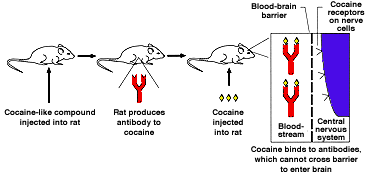NIDA-funded researchers have moved closer to finding a new approach to treating cocaine addiction by developing a cocaine-like compound that immunizes rats against many of the stimulant effects of cocaine. Acting like a vaccine that mobilizes the 's immune system to fight off diseases, the cocaine-like compound produces antibodies that reduce the amount of cocaine that can enter the brain. This research is one of the first to show how the 's immune system might be utilized to treat drug addiction.
"We have created a new scientific approach for potential treatment of cocaine abuse and maybe drug abuse in general," says the study's lead investigator, Dr. Kim D. Janda of Scripps Institute in San Diego. "We see a great deal of promise in this immunotherapy approach to drug treatment."
NIDA Director Dr. Alan I. Leshner agrees. "This is an exciting advance for drug abuse treatment research," he says. "Developing medications for the treatment of cocaine addiction is among the Nation's greatest needs, and it is one of NIDA's top priorities. Dr. Janda's research gives a promising new direction to the search for a safe means of blocking the damaging effects of cocaine, including crack."
 How Immunotherapy Blocks Cocaine's Effects. Adapted with permission from Chemical & Engineering News, 73(51):6. Copyright 1996, American Chemical Society
How Immunotherapy Blocks Cocaine's Effects. Adapted with permission from Chemical & Engineering News, 73(51):6. Copyright 1996, American Chemical SocietyThe Scripps scientists altered the cocaine molecule to create a cocaine-like compound, or analog, that stimulates the production of antibodies to cocaine. These antibodies then act like sponges that bind with cocaine in the bloodstream to reduce the amount of the drug that reaches the brain, says Dr. Janda. Dr. Janda, Dr. George F. Koob, M. Rocio A. Carrera, Dr. Peter Wersching, and their colleagues at Scripps developed a coupled molecule because cocaine itself is unstable in the , metabolizing so rapidly that it is not capable of generating cocaine-specific antibodies. To do this, the researchers reconfigured cocaine's unstable structure into a stable analog molecule that, when coupled to a carrier protein, is capable of stimulating the to produce cocaine-binding antibodies. This is because the stable analog is similar enough to the real cocaine molecule that it is recognized as cocaine by the immune system, which then produces cocaine-specific antibodies.
In the study, the researchers inoculated rats three times in a 35-day period with the cocaine analog to develop a concentration of blood anti. Then they gave the animals a dose of cocaine previously shown to cause behavioral changes in the rats. The inoculated rats displayed significantly less of the type of drug-related behavior typically observed in rodents-sniffing, rearing, and increased movement-than did the rats in the control group, which were not immunized. No unsatisfactory side effects were noted in the initial animal tests. When the rats' brains were later examined, levels of cocaine found in tissues from different areas of the brain were up to 77 percent lower in the treated animals than in the control animals.
This form of immunotherapy is called "active" immunization because antibodies are produced within the of the animal that is immunized. Dr. Janda and others are also exploring "passive" immunization, which involves the development and cloning of cocaine-binding antibodies in the laboratory. These antibodies then can be injected into the . The bee-sting vaccine used to immunize people who are extrasensitive to bee-sting toxin is a type of passive immunization, Dr. Janda explains. He and his colleagues have produced several types of passive antibodies very specific to cocaine. Dr. Janda says that they may be able to develop a cocaine treatment that is a combination therapy, involving both conjugate-produced active antibodies and laboratory-cloned passive antibodies. "Several techniques might be used together to combat cocaine addiction," he says. "There probably will not be a single 'magic bullet.'"
A key question posed by the Scripps research is how long immunization against cocaine might be effective. Follow-up animal studies have already produced a more stable type of conjugate.
"We are working to develop a cocaine therapy in which booster immunizations would be required periodically-maybe weeks or months apart. Even so, we realize that for this therapy to work with humans, the patients must be motivated to strive to maintain their immunity with periodic inoculations."
Immunotherapy against cocaine is distinctive in that it works through the immune system, not the central nervous system. Conventional medication treatment approaches seek to develop chemical variants of a drug, such as heroin, that act within the central nervous system to block or reverse the effects of the illicit drug itself. Because immunization therapy acts outside the central nervous system, it should reduce the potential for adverse side effects. This is because the cocaine antibodies-unlike cocaine itself and other drugs-cannot cross the blood-brain barrier. Cocaine molecules that bind to these antibodies are then blocked by the blood-brain barrier from entering the brain. "The advantage is that immunization should have none of the side effects associated with medications that interfere directly with parts of the brain responsible for cocaine's action," says Dr. Koob.
Adds Dr. Leshner, "Our long-term goal would be to use this type of research to develop a medication capable of immunizing cocaine users and addicts against the effects of cocaine."
In a commentary published in the same issue of Nature as the Scripps research, Dr. David W. Self of Yale University notes that the initial research with rats did not determine whether the cocaine immunotherapy reduces cocaine's reward-producing properties and, accordingly, its addictive potential. He also asks whether the counteractive effect of cocaine antibodies can be overcome by increasing the self-administered dose of cocaine or crack.
The researchers say that this and other issues, such as determining the effects of repeated immunization or booster shots, are now being addressed.
Sources
- Carrera, M.R.A.; Ashley, J.A.; Parsons, L.H.; Wirsching, P.; Koob, G.F.; and Janda, K.D. Suppression of psychoactive effects of cocaine by active immunization. Nature 378:727-730, 1995.
- Self, D.W. Cocaine abuse takes a shot. Nature 378:666-667, 1995.
